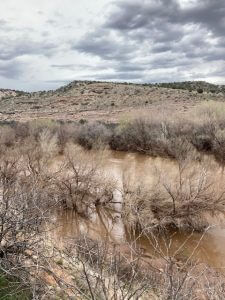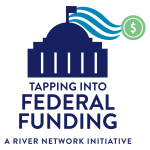Building Formal Collaboratives to Leverage Federal Funding
What does it take to build and sustain a formal collaborative and how do these collaboratives leverage federal funding to support their work? To explore these questions, River Network partnered with AMP Insights to develop case studies of coalitions across the Western United States that have effectively leveraged federal funds for river restoration and water management projects.
Now, we’re excited to share the results – including the common threads that make a successful collaborative – so that groups across the national network can replicate these Western successes and together access this important funding source, bringing more resources to communities and their rivers and other local waters.
Why Now?
Why are we interested in exploring these questions at this moment? Thanks to the Bipartisan Infrastructure Law (BIL) (also known as the Infrastructure Investment and Jobs Act or IIJA) and Inflation Reduction Act (IRA), unprecedented levels of federal funding for water projects are available right now, and nonprofits, local governments, and other entities are putting their heads together on how to leverage it. Out West, local coalitions are saddling up for $8.3 billion available from BIL for river restoration and water management projects through the Bureau of Reclamation (Reclamation), one of the West’s largest water management agency. This is more than eight times the agency’s previously largest supplemental funding appropriation (Congress Research Service 2022). Recognizing this historic moment, River Network wanted to learn from formal collaboratives who have experience leveraging federal funding so that we can better support our other members’ efforts to effectively utilize and leverage federal funding for water projects.
AMP Insights conducted interviews with partners from four collaboratives across Arizona, California, Oregon, and Idaho to inform their case study research. They explored what it takes to build and sustain formal collaboratives and different fundraising models utilized by collaboratives to leverage federal funding. AMP Insights also developed recommendations to inform how River Network can support network members in this work.
What Does It Take to Build and Sustain Formal Collaboratives and Leverage Federal Funding?
While each case study had its own flavor, six common threads demonstrated what it takes to build and sustain formal collaboratives and leverage federal funding.
- Representation from a range of community interests. Including diverse voices in collaborative building takes time, patience, and teamwork. The result is worth it, as collaboratives that represent a range of community interests are better prepared to address complex watershed challenges because they have a better understanding of the range of desires, needs, and concerns of the community. Examples from our case studies demonstrate representation from local, state, and federal entities and stakeholders, including private landowners, agricultural producers, cities and towns, conservation districts, nonprofit organizations, tribal governments, and federal and state land management agencies. Tribal representation is particularly important as tribes have been the caretakers of US landscapes for millennia and their knowledge and interests therefore germane to river restoration and water management. Diverse representation means more informed decision-making, which translates to better decisions and more competitive funding applications.
- Trust building through on-the-ground presence. AMP Insights found that when larger (particularly national-scale) organizations are part of a coalition of partners, it is important for them to develop relationships and build trust with local landowners and stakeholders. Having an on-the-ground presence in the watershed goes a long way in helping these larger organizations develop and sustain those relationships. Building trust with landowners is fundamental to be able to identify and implement any conservation project given that private individuals own about 60% of land nationwide.
- Active communication and coordination. Active communication and coordination among stakeholders and partners are essential steps in building effective collaboratives. Having a “backbone” organization that serves as the convener and fiscal agent makes collaboration more effective and efficient when applying for federal funding and carrying out project activities. However, interviewees across all the case studies mentioned that it is often challenging to acquire funding to support the time and effort needed to bring stakeholders together and sustain effective collaboration.
- Shared understanding about the key issues. What issues are most important to the community? Getting clear on the issues helps collaborative groups understand and respond to the important drivers of conservation efforts in the watershed. This is essential in designing and implementing conservation actions that align with the needs and wants of the community and various funders. Shared understanding of key issues translates to better internal and external communication, including with funders.
- Effective community outreach. Effective community outreach programs help educate landowners and community members about the benefits of conservation actions to improve stakeholder buy-in. Outreach to the community also serves to help help collaboratives identify conservation actions that have community support and can be realistically implemented through landowner agreements. Similar to trust building, interviewees shared that it is challenging to secure funds explicitly for community outreach.
- Access to unrestricted funding for staffing and capacity building. Collaboratives must spend significant time and energy on outreach, development, and maintenance of landowner and stakeholder relationships, project site evaluation, and project planning. However, funding for this type of work is often difficult to acquire. Many smaller, local nonprofit organizations have a particularly difficult time submitting competitive grant applications that require significant investment of time and resources to successfully secure federal and other types of funding for their projects. This case study research found that partnering with a larger organization with more resource development capacity and familiarity with grant proposal processes is often necessary to successfully bring federal and other project funds into the watershed.
What Is Unique About Each Funding Model?
No two collaboratives are funded or supported in the same way. Below, we have highlighted unique characteristics of the funding models for each of the four case studies.

The Verde River in March 2023. Photo by Katherine Baer.
Deschutes River Conservancy (DRC): In its early years, DRC was authorized to receive direct congressional appropriations through the Bureau of Reclamation. This allowed for substantial federal funding to be funneled more efficiently to the partnership. Partners have since received additional federal funding from Bureau of Reclamation, USFS, USFWS, NRCS and Bonneville Power Administration (through NFWF).
Russian River Coho Water Resources Partnership: The partnership received its initial keystone investment from NFWF in 2009. NFWF used US Fish and Wildlife Service money as a base for the annual grant, with periodic additions from private donors. This investment lasted 11 years and totaled $6 million with an additional $10.6 million leveraged in grantee match. NFWF providing essential funding for relationship-building, programmatic design of the partnership, outreach and project development, and setting up fisheries and streamflow monitoring.
Friends of the Teton River (FTR): FTR operates out of a small, tight-knit community. The organization has excellent staff longevity and little turnover, which helps build trust and confidence between their organization and funders. Initial funding was secured through one-off grants for specific projects, but this model limited by how many unrestricted (non-federal) dollars FTR could bring in. Their approach has since shifted to seeking multi-year grants.
Verde Watershed Restoration Coalition (VWRC): Friends of the Verde River serves as the fiscal agent and convener for VRWC. The coalition is supported by a mixture of foundation funding and state and federal funding, and it has a working group dedicated to developing a sustainable revenue stream for its work in the Verde that meets once per month. In addition, The Nature Conservancy has been a significant funding partner to Friends of the Verde River, collaborating on joint funding proposals and helping to identify new funding opportunities.
To hear from a member of each collaborative, check out our April 2023 Meet Your Network roundtable.
Next Steps for River Network
This case study research led to several recommendations from AMP Insights to River Network that our staff in the Colorado River Basin will address through the following next steps. First, staff will seek additional opportunities to present these case studies and key takeaways to key partners to educate and inspire them regarding alternative models for fundraising. Second, staff will explore future opportunities to support groups seeking to establish or develop formal collaboratives in the Colorado River Basin. Recommendations from AMP Insights suggest that we do this through convening partners, cultivating funder support, and acting as technical expert to key stakeholders.
Are You Interested in Building a Formal Collaborative?
If you live in a Western state and your organization is interested in building a formal collaborative, now is the time! Reclamation’s Cooperative Watershed Management Program is aimed at helping diverse stakeholders to work together on finding local solutions to address their water management needs. This program is housed under the WaterSMART (Sustain and Manage America’s Resources for Tomorrow) programs and received $100 million through IIJA. Funding supports formation of a formal watershed group and development of a watershed plan, and groups are eligible for up to $200,000 with no cost share required. The next funding announcement will likely be released in early summer 2023.






